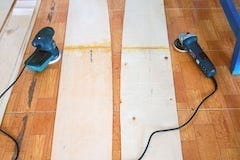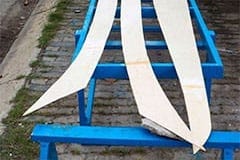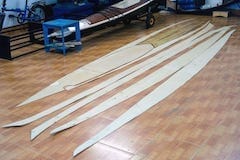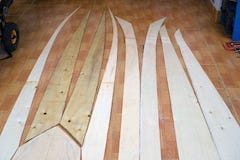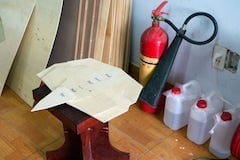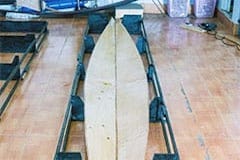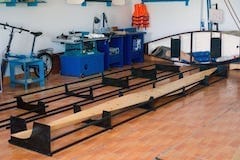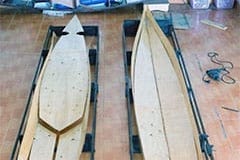The S & G Night Heron plan calls for beveling the bilges’ edges, and I follow it exactly, the bevels will help forming the boat shape more precisely, and also help to strengthen the putty joints. At first, I intended to use my routers to do the edges’ beveling, but switch to the frequently – used angle grinder instead. With the angle grinder, it’s harder to do the job, but it allows you to adjust the angle along the bilges, it’s steeper toward the boat’s aft and bow.
Next, I would add several layers of ‘penetrating epoxy’ onto the joined planks. This is my own experience in dealing with plywood, epoxy, and glassing. ‘Penetrating epoxy’ is nothing more than epoxy (with slow hardener, the B5) thinned with a solvent, I use xylene, which works best for me, mixed in 4/6 ((resin + hardener) / solvent) ratio. The plywood I could find here in Saigon is usually not of very high quality, I can see it absorb lots of thinned epoxy cause the veneer is so porous.
Using a slow hardener plus a solvent (applied in 3, 4 layers) causes the epoxy to cure slowly, usually within 12 ~ 18 hours. This prolonged time allows the plywood to absorb a significant amount of epoxy, and hence strenghthen the veneer. I estimate that the ‘penetrating epoxy’ adds up about 1 ~ 1.2 kg to the boat’s final weight, but that also helps glassing in the next steps to be more clean and strong, no more ‘white spots, white areas’ in fiberglass cause the wood is already well – saturated.
‘As usual’, I have the unpleasant feeling working with these long, narrow stripes of plywood. At this stage, they are very fragile and delicate, easy to break at any moment. But all would gradually build up strength once stitched together into a structure, have the seams filled with putty, and especially after being reinforced with fiberglass and epoxy. Nevertheless, it’s a very good feeling at this step to see the boat takes its initial shape, I work first on the hull, then proceed to the deck part.

